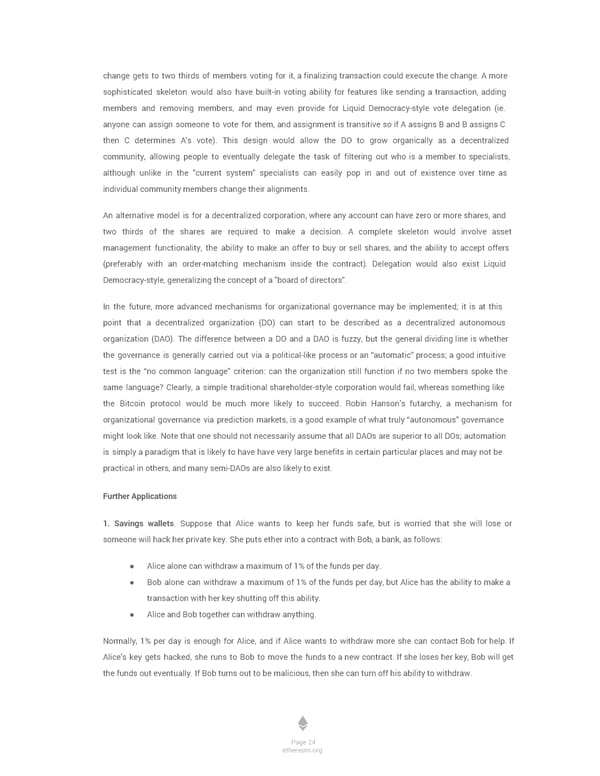change gets to two thirds of members voting for it, a finalizing transaction could execute the change. A more sophisticated skeleton would also have built-in voting ability for features like sending a transaction, adding members and removing members, and may even provide for Liquid Democracy-style vote delegation (ie. anyone can assign someone to vote for them, and assignment is transitive so if A assigns B and B assigns C then C determines A's vote). This design would allow the DO to grow organically as a decentralized community, allowing people to eventually delegate the task of filtering out who is a member to specialists, although unlike in the "current system" specialists can easily pop in and out of existence over time as individual community members change their alignments. An alternative model is for a decentralized corporation, where any account can have zero or more shares, and two thirds of the shares are required to make a decision. A complete skeleton would involve asset management functionality, the ability to make an offer to buy or sell shares, and the ability to accept offers (preferably with an order-matching mechanism inside the contract). Delegation would also exist Liquid Democracy-style, generalizing the concept of a "board of directors". In the future, more advanced mechanisms for organizational governance may be implemented; it is at this point that a decentralized organization (DO) can start to be described as a decentralized autonomous organization (DAO). The difference between a DO and a DAO is fuzzy, but the general dividing line is whether the governance is generally carried out via a political-like process or an “automatic” process; a good intuitive test is the “no common language” criterion: can the organization still function if no two members spoke the same language? Clearly, a simple traditional shareholder-style corporation would fail, whereas something like the Bitcoin protocol would be much more likely to succeed. Robin Hanson’s futarchy, a mechanism for organizational governance via prediction markets, is a good example of what truly “autonomous” governance might look like. Note that one should not necessarily assume that all DAOs are superior to all DOs; automation is simply a paradigm that is likely to have have very large benefits in certain particular places and may not be practical in others, and many semi-DAOs are also likely to exist. Further Applications 1. Savings wallets. Suppose that Alice wants to keep her funds safe, but is worried that she will lose or someone will hack her private key. She puts ether into a contract with Bob, a bank, as follows: ● Alice alone can withdraw a maximum of 1% of the funds per day. ● Bob alone can withdraw a maximum of 1% of the funds per day, but Alice has the ability to make a transaction with her key shutting off this ability. ● Alice and Bob together can withdraw anything. Normally, 1% per day is enough for Alice, and if Alice wants to withdraw more she can contact Bob for help. If Alice's key gets hacked, she runs to Bob to move the funds to a new contract. If she loses her key, Bob will get the funds out eventually. If Bob turns out to be malicious, then she can turn off his ability to withdraw. Page 24 ethereum.org
 Ethereum White Paper by Vitalik Buterin Page 26 Page 28
Ethereum White Paper by Vitalik Buterin Page 26 Page 28